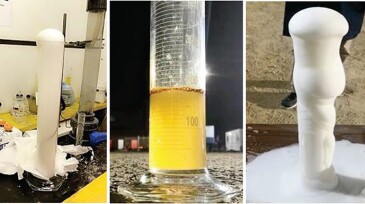Acidizing/stimulation
This study explores enhancing gas production through a novel combination of prestimulation using a coiled tubing unit and high-rate matrix acidizing.
The authors of this paper describe a method of stimulating a multizone hydrocarbon-producing well wherein a tool is deployed downhole by wireline to generate acid vapor at a target depth, allowing each interval to be treated uniquely.
In this work, microseismic observations are integrated with strain and other observations to investigate the microseismic response in relation to the underlying hydraulic fracture geometry for different rock types.
-
This paper describes the analysis of actual performance data for acid fracturing in a tight carbonate formation to investigate the ineffectiveness of the process.
-
The first acid job dates to 1895. Challenges remain, however, when it comes to lithology, coverage, penetration, and management of reaction products. These themes remain a focus for stimulation engineers.
-
This paper presents a novel mathematical model for design and evaluation of fluoroboric acid treatments that takes into account the chemical kinetics and equilibrium aspects of important reactions and fluid flow inside the reservoir rock.
-
This paper presents design considerations and field-trial applications for determining practical dimensions and limits for interdependencies associated with stage length, perforation clusters, and limited-entry pressures.
-
This paper focuses on identifying a hydrofluoric-acid-derivative treatment that could be used as a single-step sandstone-acid treatment with all the associated benefits but without the need for acid-flowback services.
-
To improve the productivity index of a well in a carbonate reservoir offshore Abu Dhabi, a multilateral acid-jetting technology was adopted as a more-effective alternative to typical drainage methods.
-
It is pleasantly surprising to find a revival in sandstone acidizing. For many years, sandstone acidizing was becoming almost a lost art, overshadowed by carbonate acidizing and hydraulic fracturing.
-
The authors describe a self-breaking, formation-damage-free, novel nanoparticle-based gelled-acid system to replace polymer-based gelled-acid systems.
-
The authors describe the benefits of a single-phase retarded inorganic acid system, which they write features the same benefits as emulsified acids while eliminating the drawbacks of the latter.
-
This paper presents a novel sandstone-stimulation technique using thermochemical fluids.













